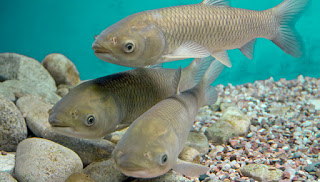Posted May 14th, 2015 in
Aquatic Invasive Species INVASIVE SPECIES EDITION—Where we take a moment to explore the species that threaten the Great Lakes region.
They may not be what comes to mind when you think of invasive carp, but grass carp can have drastic and lasting impacts on aquatic ecosystems and water quality. Originally from eastern Asia, they have been introduced the world over as a biocontrol for aquatic weeds and can now be found in over 70 countries.
This wide range is made possible by their versatility—not unlike the hydrilla they are sometimes employed to eliminate. Grass carp can live in water temperatures from below freezing to over 100ºF, can survive in brackish waters, and are able to tolerate low-oxygen environments.
 While they live mostly in slow moving and still waters, eggs are spawned in fast rivers, and must remain suspended for two to four days before they hatch. From there, grass carp grow quickly—as much as 10 inches in the first three months. An adult can grow to be upwards of 4 feet in length and more than 50 pounds on a diet of mostly aquatic weeds. But they have also been known to consume detritus, insects, and other invertebrates as well.
While they live mostly in slow moving and still waters, eggs are spawned in fast rivers, and must remain suspended for two to four days before they hatch. From there, grass carp grow quickly—as much as 10 inches in the first three months. An adult can grow to be upwards of 4 feet in length and more than 50 pounds on a diet of mostly aquatic weeds. But they have also been known to consume detritus, insects, and other invertebrates as well.
Grass carp were first brought to the U.S. in 1963 when they were imported from Malaysia and Thailand to aquaculture facilities in Alabama and Arkansas. Their first release into the wild is believed to have happened three years later when some escaped from the U.S. Fish and Wildlife Service Fish Farming Experimental Station in Stuttgart, Arkansas. Planned introductions began in 1969 in an effort to control nuisance plants. By the end of the 1970s, grass carp had been introduced in 40 states. Today it can be found in 45 states, with well-established populations throughout the Mississippi River Basin.
Grass carp are a highly regulated species, and for good reason. Because they are so adept at consuming plants, there is a risk that these veritable aquatic lawnmowers might leave a waterbody completely devoid of plant life and wipe out the food supply for other fish, insects, and waterfowl. A lack of plant life can also spur on algal blooms, which in turn lower oxygen levels. And without roots to keep sediment secure, the water is likely to become muddied, and spawning beds for other fish can be destroyed.
Because of these and other risks, grass carp used for weed control are sterilized by shocking the eggs with drastic changes in either temperature or pressure. But this process is not 100 percent effective, and fish sometimes escape into the wild. In some states, including Illinois, the use of grass carp is restricted to private ponds or pools. Those thinking about using the fish for personal use are encouraged to explore other weed-control options.

 While they live mostly in slow moving and still waters, eggs are spawned in fast rivers, and must remain suspended for two to four days before they hatch. From there, grass carp grow quickly—as much as 10 inches in the first three months. An adult can grow to be upwards of 4 feet in length and more than 50 pounds on a diet of mostly aquatic weeds. But they have also been known to consume detritus, insects, and other invertebrates as well.
While they live mostly in slow moving and still waters, eggs are spawned in fast rivers, and must remain suspended for two to four days before they hatch. From there, grass carp grow quickly—as much as 10 inches in the first three months. An adult can grow to be upwards of 4 feet in length and more than 50 pounds on a diet of mostly aquatic weeds. But they have also been known to consume detritus, insects, and other invertebrates as well. 
